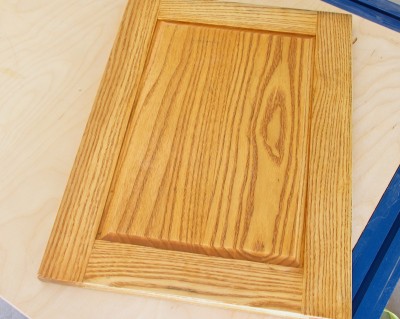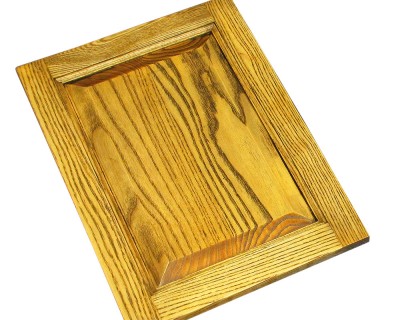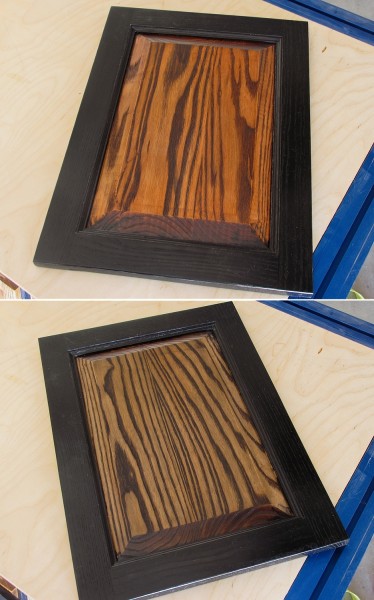by Mark Stephens Apr 4, 2016 Comments

Ash stained with a Maple colored oil stain. Notice how well ash takes the stain. But there’s still a lot more you can do with ash.
You might not find a wood that stains as well as ash does. Its natural pale color allows it to agree with just about any color you can imagine, and basic oil stains take to it evenly without the need for a conditioner or a washcoat.
Products used: Old Masters Maple Wiping Stain
A successful stain job starts with a well prepared surface. Ash should be sanded to 220 or perhaps 320 grit, but no finer. A general rule about staining is that there’s a sweet spot at which a wood is sanded to a just-right grit. If you’ve sanded to a too-coarse grit the stain highlights scratches, and if you’ve sanded too fine the wood won’t accept the stain very well. Ash is forgiving and easy to sand, so a 220 to 320 grit window is a safe bet.
Like most oil stains, the stain pigment gets delivered into the large open pores in ash and create a darker color in the grain. With a little imagination and knowledge of how other finishing products work, you can create some exciting and dramatic finishes in ash with a little bit of stain.

Believe it or not, this door is stained with the same maple oil stain. The difference is in the two steps that followed the stain.
Building on the concept of using a basic oil stain to color ash, you can also add extra contrast for a unique look. This door at right is stained with the exact same stain as the door above. The difference is that we applied another darker stain on top of the first color.
Products used: Old Masters Maple Wiping Stain, Zinsser SealCoat, Old Masters Spanish Oak Wiping Stain.
Here’s what’s happening in the process. The first stain color establishes the basic overall color you want. The sealer puts a clear barrier between the two stain colors. The second stain then won’t color the wood, instead it to only deposits color into the open pores. Simply wipe it on and wipe it off while it’s still wet.
The wood takes on a darker yellow color while the pores are darkened virtually black, creating a look that’s not too unlike the coloring of a tiger’s coat of fur.

You can do some very wild things with dye and woodgrain filler on ash. Bright colors, solid black, and high contrast.
Ash also accepts dyes remarkably well, and it also can be grain-filled when you want to lay down a perfectly smooth topcoat. Here are a couple of samples that use colorful dye and black-tinted woodgrain filler under a lacquer clear coat.
Products used: Solar-Lux Brown Maple Dye, Solar-Lux Jet Black Dye, Zinsser SealCoat, Old Masters Woodgrain Filler, Old Masters Spanish Oak Wiping Stain.
Steps used on the panel:
Steps used to make the frame jet black:

Ash likes to take wood grain filler, too. Here we left the natural color of the wood but applied a black grain filler to demonstrate the contrast.
Why color the wood if you don’t want to? Here’s a way to improve the natural contrast in ash while keeping its main pale color.
Products used: Zinsser SealCoat, Old Masters Woodgrain Filler, Old Masters Spanish Oak Wiping Stain.
Here’s a slightly different approach. You can also dye ash solid black – or build on the solid black color by making this pores white. Here’s how.
Products used: Solar-Lux Jet Black aniline dye, Zinsser SealCoat, Old Masters Pickling White Gel Stain.
Vice President of Operations – Woodworkers Source
We’re a family-owned lumber & woodworking supply retailer with 3 delightful stores in Arizona, and 35 friendly employees.
Mark oversees the company and creates tutorials on wood finishing and woodworking tips for hardwood lumber.
Woodworkers Source is a division of MacBeath Hardwood Co.
Phoenix 602-504-1931
Tempe 480-355-5090
Tucson 520-745-8301
18115 N. Black Canyon Hwy
Phoenix, AZ 85023
[email protected]
602-504-1931
645 W. Elliot Road
Tempe, AZ 85284
[email protected]
480-355-5090
3441 S. Palo Verde
Tucson, AZ 85715
[email protected]
520-745-8301

